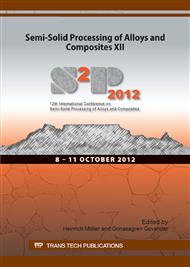p.305
p.311
p.317
p.323
p.329
p.335
p.341
p.347
p.353
Rheological Characterization of Semi-Solid A356 Aluminium Alloy
Abstract:
Rheological behavior of semi-solid slurries forms the backbone of semi-solid processing of metallic alloys. In particular, the effects of several process and metallurgical parameters such as shear rate, shear time, temperature, rest time and size, distribution and morphology of the primary phase on the viscosity of the slurry needs in-depth characterization. In the present work, rheological behaviour of the semisolid aluminium alloy (A356) slurry is investigated by using a high temperature Searle type Rheometer using concentric cylinders. Three different types of experiment are carried out: isothermal test, continuous cooling test and steady state test. Continuous decrease in viscosity is observed with increasing shear rate at a fixed temperature (isothermal test). It is also found that the viscosity increases with decreasing temperature for a particular shear rate due to increasing solid fraction (continuous cooling test). Thixotropic nature of the slurry is confirmed from the hysteresis loops obtained during experimentation. Time dependence of slurry viscosity has been evaluated from the steady state tests. After a longer shearing time under isothermal conditions the starting dendritic structure of the said alloy is transformed into globular grains due to abrasion, agglomeration, welding and ripening.
Info:
Periodical:
Pages:
329-334
Citation:
Online since:
October 2012
Keywords:
Price:
Сopyright:
© 2013 Trans Tech Publications Ltd. All Rights Reserved
Share:
Citation:


